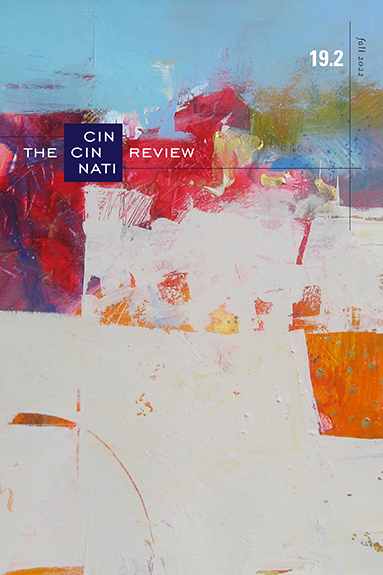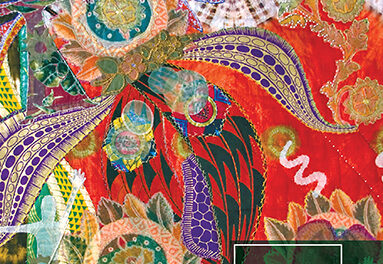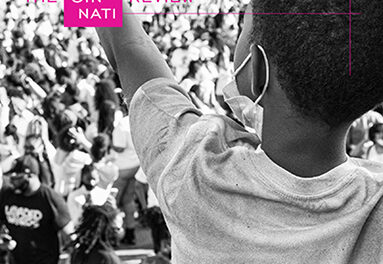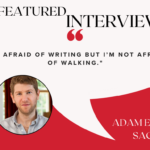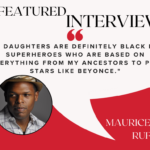We are pleased to share this review by Emma Hudelson of Horse Girls: Recovering, Aspiring, and Devoted Riders Redefine the Iconic Bond, which appeared in Issue 19.2 as part of a special multigenre review and essay feature on anthologies (read the entire feature here):
Horse Girls: Recovering, Aspiring, and Devoted Riders Redefine the Iconic Bond. Ed. Halimah Marcus. Harper Perennial, 2021. 304 pp. $17.00 (paper).
Being a horse girl isn’t easy.
First, there are the stereotypes, which change with age. As a schoolgirl, she keeps her hair in a ponytail, wears riding boots to school, and “canters” around the track alone for the one-mile run. Alone. In her room hang ribbons she’s earned at horse shows. On her shelves are Marguerite Henry books and rows of Breyer model horses. Then the teenager, still wearing the ponytail and boots, but now posting a selfie with her horse, her lips brushing his muzzle. Then, later, the woman in her thirties, newly financially stable, trying to fit horses back into her life now that she signs the farrier’s checks herself. Her peers are getting married, or at least dating, but she spends her time on horseshowsonline.com, not Tinder. Just as well.
In the real world, horse girls must contend with real concerns about class, race, and identity. Horses are a rich woman’s game. The average member of the United States Equestrian Federation, or USEF, an organization that is 85 percent female, has a net worth of nearly $1 million. Her home value is $600,000, and about a quarter of the members own two or more homes. In a 2012 Slate article, Mary Mycio, herself a horse girl, calls the equestriennes in an issue of Town and Country “billionaire princesses,” writing, “Full disclosure: I own a horse, but I am not a billionaire princess.” Horse girls often wear the tack (sorry) of popularity: white, wealthy, cisgender, and heterosexual.
Halimah Marcus’s 2021 essay anthology Horse Girls deals with both stereotypes and the larger issues they can signal. In it, fourteen writer-riders—an aural cognate whose significance isn’t lost on Marcus, and one she expands upon in her introduction—dissect their experiences with horses. Some have only touched a horse for a few hours. Others have owned multiple horses. Still others had to wait for womanhood to find themselves on horseback. All identify or once identified as female. All share a love for horses, even if it’s been years since their hips hit a saddle. Horse Girls is a love letter to the bond between horses and women, but it illustrates that bond without sentimentality, each essay constructing the complexity of that bond using the nonfiction tools of real-life scene and narrator reflection, both the narrative “eye” and narrative “I.”
My own full disclosure? I’m exactly what you might imagine when picturing a horse girl grown up. Like Mary Mycio, I own a horse and am, regrettably, not a billionaire princess. I am white, with dirt beneath unmanicured nails and long hair that sometimes has hay in it; I am slender enough to squeeze into my jodhpurs from adolescence. Even when surrounded by women with trust funds, my whiteness, heterosexuality, and cisgenderedness have always let me feel comfortable in horsey spaces.
Of course, not all horse girls look and live like me. Horse Girls shines in including an array of perspectives. Of its fourteen essays, half are by Black, Indigenous, Latinx, multiracial, or queer writers. About 90 percent of USEF members are white, making these identities in Horse Girls ones that are underrepresented in barn aisles, so their presence in this anthology is a relief. Many of Horse Girls’s essays deal with the challenges of not fitting in. Being a horse girl is challenging enough. Being, say, a Black barrel racer in Texas, as Sarah Enelow-Snyder writes about in “A Racer without a Pedigree,” is harder. Competing against “contestants with smooth blond hair, glittery pink eyeshadow, and confident smiles,” she struggles to find her place, both in the winners’ circle and in herself. Enelow-Snyder recounts her humiliations and discomfort in clear prose that borders on flatness. That’s fine by me. In one scene, Enelow-Snyder describes a supposed (white) friend yanking her hair, “harder and harder, until I thought she was going to rip hair from my scalp.” Scenes like that don’t need to be steeped in metaphor. They’re enough on their own, and there are plenty of them in this essay. While each essay in Horse Girls tackles different themes, the reins (so sorry) holding them together are the same: no matter how uncomfortable these women have been made to feel in horsey spaces, on the page, they soar.
Finding connection, escape, and solace on horseback is a tale told over and over again in these pages. Braudie Blais-Billie writes, “in our family . . . horses are how we survive.” As a half-Seminole, half–French Canadian woman, Blais-Billie spent her girlhood trying to fit into two worlds and never succeeding. Nur Nasreen Ibrahim can forget about her “horselike nose” and “thin hair” in the horse-filled village of Nathiagali, five hundred kilometers from her home in Lahore, Pakistan. Alex Marzano-Lesnevich, who is trans, writes of their childhood riding lessons, “I found what I longed for every time Carefree broke free of the trot, shrugged off my cautious reins, and galloped. . . . Carefree, I loved.” After a section break, Marzano-Lesnevich time travels. “The year is 1816, and a tall girl named Sarah Dowling who refuses—scandalously—to wear a dress comes knocking at the door of Patience White.” This is a summary of the opening to the 1969 lesbian novel Patience and Sarah by Alma Routsong. Marzano-Levenich breaks up their essay with research into nineteenth-century trans characters, both real and fictional. Horses and the nineteenth-century American frontier are laminated into a symbol of freedom—freedom from the body, from gender, from self. In self-aware prose, Marzano-Levenich uses history to crack their own past open, the breaks in linear plot providing insight into their sense of identity: “If I’d known back then, is what I think every time I discover such a story. If I’d known. If only I’d known.”
Breaking a linear plotline is nothing new, especially for narratives of trauma and identity, and some of the essays in Horse Girls buck (again, sorry) convention, becoming lyric essays that defy genre expectations. Carmen Maria Machado’s “Horse Girl: An Inquiry” is the most formally inventive essay in the collection. In it, she writes brief titled vignettes that characterize a girlhood marked by difference: “Fat. (Though I wasn’t, not really, not yet.) Queer. (I didn’t know I was, but maybe they knew?) Latinx. (Despite a robust nonwhite tradition of horseback riding . . . ).” Each vignette speaks to the others, creating a dizzying, beautiful cathedral window of horse-worship in which the animal is revealed as a totem of beauty and belonging, two qualities the adolescent Machado did not feel she had. The essay ends in a series of rapid-fire questions, allowing Machado to interview herself. Each Q & A allows Machado to shift subjects without transition, moving associatively rather than linearly. The effect is relentless, as if the essay’s narrator were digging into herself until she arrives at an answer to the question that seems to have sparked the entire essay: “What Were Horses to Me?” The answer? “A beauty that could be borrowed.”
In another essay that aims to answer questions, “I Don’t Love Horses,” T Kira Madden braids an investigation of a 1991 movie familiar to any self-respecting horse girl, Wild Hearts Can’t Be Broken, with an exploration of her own horsey past and present. Among other questions, she explores the idea that the horse does all the work—a misconception common to nonriders. Having been on two state-park trail rides on mounts so sedate they might as well have been sofas, some people conclude, “All you’re doing is sitting there.” Most equestrians roll their eyes and change the subject, but Madden centers her essay on that question. She’s interested in the emotional labor of horses, not just the physicality that passes, electric, between horse and rider. Because, as she says, “everyone knows horses are therapy,” Madden concludes: “Yes. . . . The horse does all the work.” Marcus opens the book with Madden’s essay, but she is far from the only writer-rider in this book for whom horses provide solace. On his long back, the horse carries more than his human’s physical weight. He holds hopes, sorrows, and fears and transmutes them into motion. Into partnership. In the thirteen essays that follow Madden’s, the horse becomes more than a horse.
In “Daredevils,” Maggie Shipstead resists the popular idea, rooted in Sigmund and Anna Freud’s work, that horses symbolize sex, especially for girls. Shipstead writes,
The minds of girls are treated . . . [as] gauzy pink zones of confusion where the desire to ride a horse is indistinguishable from wanting to have sex with a man.
I blame Freud.
Though seeing Freud in an essay makes me roll my eyes, in “Daredevils” it’s a necessary reference. The conflation of horseback riding, power, and sex is so common (note that the trappings of S & M dungeons look much like a tack room in a stable) that Shipstead needs to trace it back to its roots. On a horse, Shipstead enjoys not domination but connection, a feedback loop that comes from the physical closeness necessary to ride. Horses help Shipstead face her anxieties, but not in a simple exchange of power. Instead, horses become the site of epiphany, which is, according to Shipstead, both the goal and bane of beginning fiction writers. In real life, she explains, epiphanies unfold slowly. In an example of content-becoming-form, Shipstead’s entire essay enacts this process. The essay opens with the narrator remembering herself at age five, fearing a visit to Niagara Falls. It ends with a narrator who, some thirty years later, travels to Botswana for a “horseback safari” that requires the rider to “be able to gallop out of danger.” Horses are the catalyst for this slow transformation. For Shipstead, and for most women who ride, riding is a complex relationship. On horseback, we horse girls borrow power—or courage, or freedom, or whatever it is that we lack. If we’re lucky, we retain a little of it once both feet are back on the ground.
Many essays in Horse Girls cover a lot of ground. In recounting an entire life with horses, or a distant past life with horses, some pieces end up without enough flesh-and-blood horses on the page. Abstract horses don’t elicit the same emotional response as real ones rendered in vivid sensory detail. The anthology is at its best when the pages are filled with horse breath, hay-tinged and warm. Take this passage from Rosebud Ben-Oni’s “We Aren’t Close to Anywhere,” which might be my favorite essay from this anthology: “I laid my head against his still-damp coat. I could hear him breathing. I still do. I will always remember that deep chamber of being, the rising and falling of him. I left part of myself there, within him, in that soft, baked earth of an eye, his wet terra-cotta eye . . .” Ben-Oni’s lyric travelogue of a week spent on horseback in Iceland riding a stallion named Odin also narrates her return to her own body. Chronic illness robbed her of trust in her physical form; a horse returned that trust. Once she climbs on horseback, the prose unravels into single-sentence paragraphs.
For a moment I was in the suspension of a horse’s breath.
Somewhere, the restless ghost quieted her anxious desire to make herself known, that parts of my old self were still here.
Somewhere, she wrestled herself into an idea of just becoming by being.
The sentences breathe along with the silent horse and rider, mimicking the shift from mind to body that happens on horseback. Moments like the ones quoted above appear throughout the book, evoking the embodied experience of working with horses.
Horse Girls isn’t the first anthology of essays about horses by self-identifying horse girls, but it’s among very few of its kind, and it’s the first with the privilege that comes with a HarperCollins imprint. Like in Ben-Oni’s piece, personal essays can recount and reflect on embodied experience, making them well-suited vehicles for the subject of animals, beings who are all about embodiment. Horses, after all, can’t narrate their own experience. If they could, I suspect their prose would be nonlinear and full of sensory detail, as many of these essays are. Horse Girls is unique, filling an empty stall (I’m sorry, really, I am) in a stable (okay, maybe I’m not sorry) of equine literature that’s otherwise populated by YA novels and how-to books. Marcus’s anthology is for real-life horse girls—or, more accurately, the women they grew up to be—but it’s also for anyone interested in the ways animals beautify the human experience. As Carmen Maria Machado writes, “Can you borrow beauty? . . . Can you be beautiful without a beautiful creature beneath you? I’m still not sure I know.”
Emma Hudelson is a nonfiction writer from Indiana. Her book Skywatch: The Untold Story of America’s Greatest Show Horse will be out in 2023 from the University Press of Kentucky. Her work appears in Chattahoochee Review, The Rumpus, and elsewhere, and she writes regularly for Saddle & Bridle.

